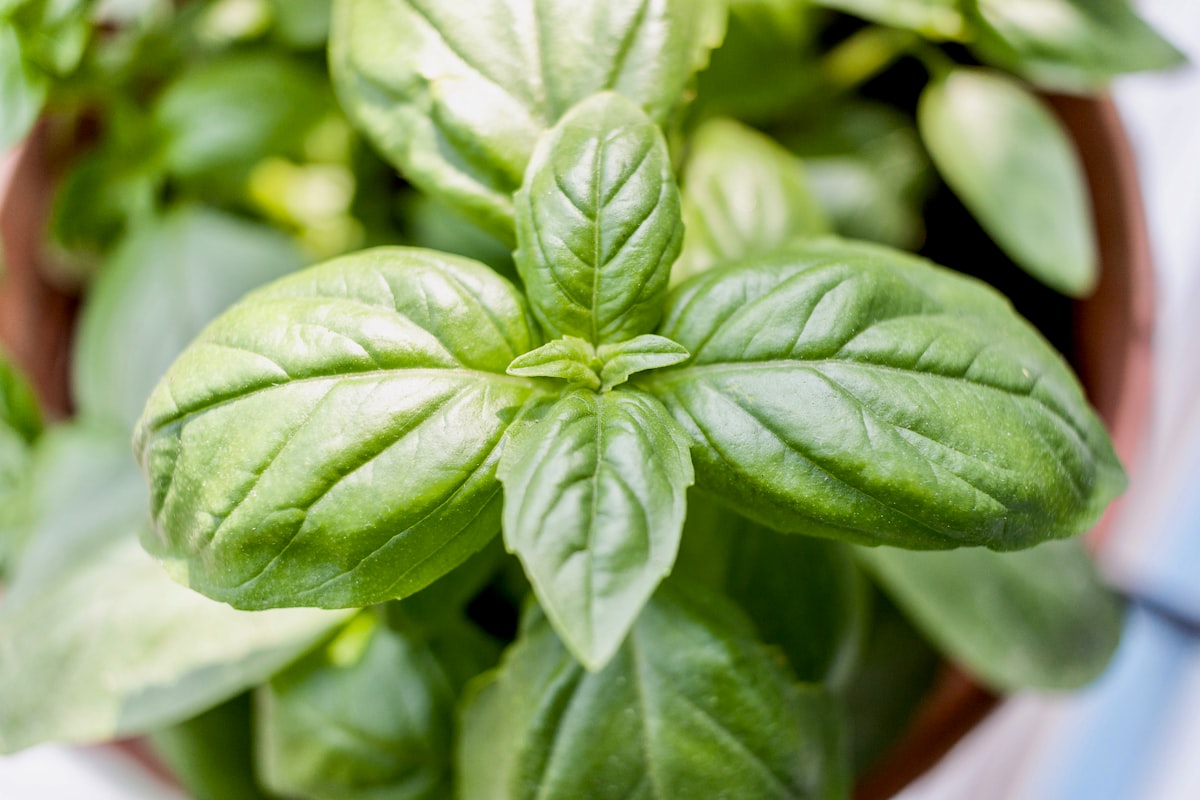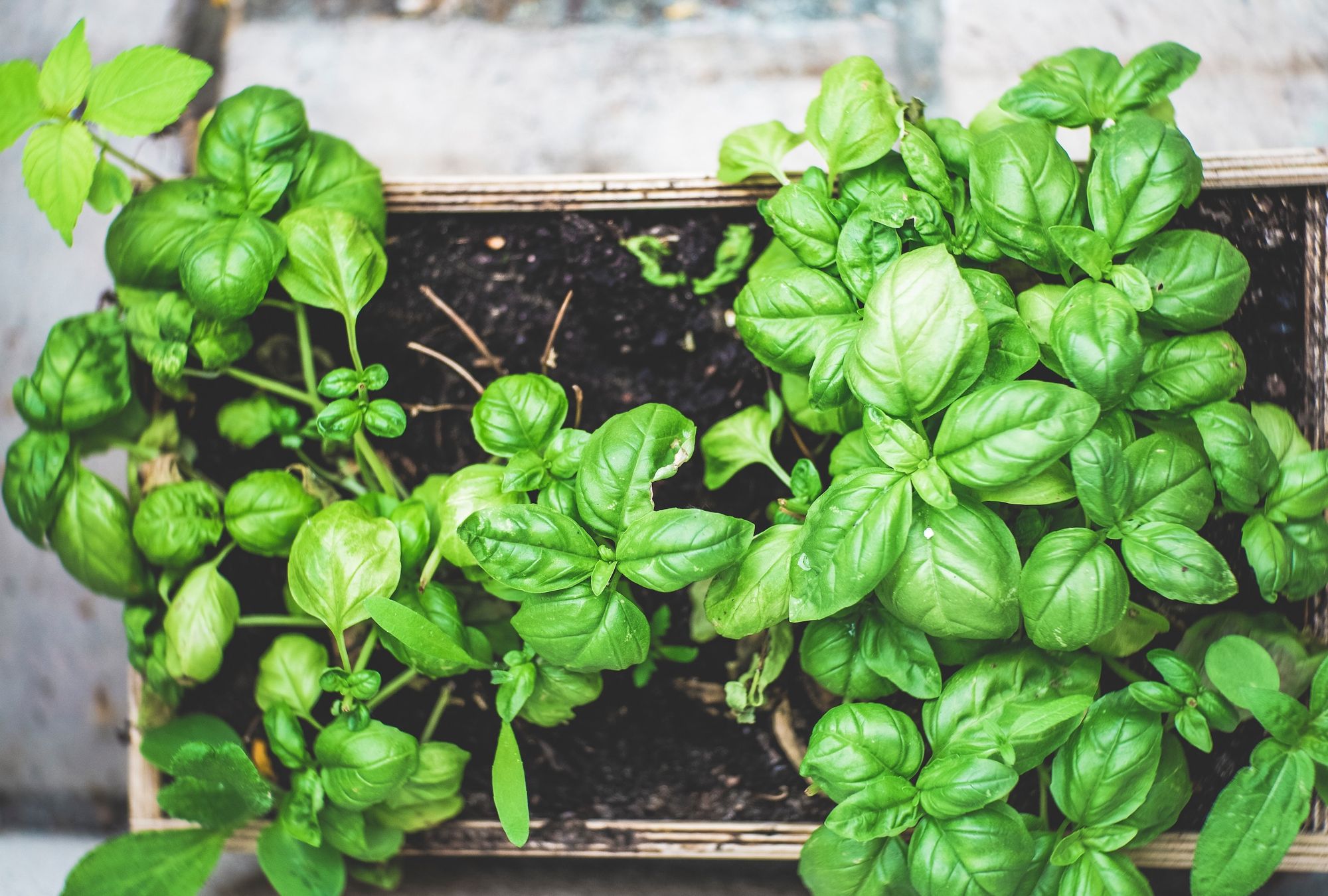How to Grow Basil
Planting basil is a simple and rewarding task that anyone can do, regardless of their gardening experience.

Before planting, make sure to choose a sunny spot with well-draining soil. Basil is a warm-weather herb, so it thrives in temperatures between 70-80°F.
To start planting basil, you can either plant seeds directly in the ground or start them indoors and transplant them later.
- If planting seeds directly in the ground, sow them about ¼ inch deep and 10-12 inches apart.
- If starting indoors, sow seeds in pots filled with potting soil and keep them in a warm, sunny spot until they sprout.
Once the seedlings have grown a few inches tall, you can transplant them outdoors.
When planting basil, it's important to water the plants regularly, but be careful not to overwater. Basil prefers moist soil, but too much water can lead to root rot.
Additionally, prune your basil regularly to encourage bushy growth and prevent it from getting too tall and leggy.
Understanding Basil
Basil is an annual herb that belongs to the Ocimum basilicum family.
It is a popular herb commonly used in cooking due to its unique flavor and aroma. Basil comes in several varieties, each with its distinct taste and scent.
Basil is an easy-to-grow herb commonly grown in gardens and containers. It prefers full sun and well-drained soil that is slightly acidic to neutral.
The plant can grow up to 24 inches tall with green oval-shaped leaves.
It is important to note that Basil is an annual herb, which means it completes its life cycle in one growing season.
The flavor and aroma of basil can vary depending on the variety. Sweet basil is the most common variety and has a slightly sweet and peppery taste.
Other varieties of basil include lemon basil, Thai basil, and purple basil. Lemon basil has a citrusy flavor, while Thai basil has a spicy and licorice-like taste.
Purple basil has a sweet and mild flavor and is often used for decorative purposes.
Overall, basil is a versatile herb that can be used in various dishes, including pasta sauces, salads, and soups.
Varieties of Basil
Basil is a versatile herb that comes in many different varieties.
The most common types of basil are sweet basil, lemon basil, Thai basil, purple basil, and cinnamon basil.
Each variety has its unique flavor and aroma, making it a popular choice for many dishes.
- Sweet basil, or Genovese basil, is the most popular variety. It has a sweet, slightly spicy flavor and is commonly used in Italian cuisine.
- On the other hand, Thai basil has a more pungent, licorice-like flavor and is often used in Southeast Asian dishes.
- Lemon basil has a citrusy flavor, adding a fresh, bright taste to salads and seafood dishes.
- Purple basil has a slightly spicy, clove-like flavor and is often used as a decorative garnish.
- Cinnamon basil has a sweet, cinnamon-like flavor, adding depth to desserts and baked goods.
Overall, there are many different types of basil to choose from, each with its unique flavor and aroma. Experiment with different varieties to find the best ones for your favorite dishes.
Starting with Basil Seeds
To start growing basil from seeds, you will need to purchase high-quality basil seeds from a reputable source.
Basil seeds germinate within 5-7 days under the right conditions, so choose fresh seeds that have been stored properly to ensure a high germination rate.
Once you have your basil seeds, it's time to prepare the soil. Basil seeds require well-draining soil that is rich in organic matter.
You can purchase a pre-made potting mix or make your own by mixing equal parts of peat moss, vermiculite, and perlite.
Fill your seed tray or pot with the soil, leaving about 1/4 inch of space at the top.
Next, it's time to plant the seeds. You can sprinkle the seeds directly onto the soil or plant them individually. Cover the seeds with a thin layer of soil, about 1/4 inch deep.
Water the soil gently, making sure not to displace the seeds. Place the seed tray or pot in a warm, sunny location, and keep the soil moist but not waterlogged.
In a few days, you should see the first signs of germination.

Planting Basil
To plant basil, choose a sunny spot in your garden or containers that receive at least six hours of direct sunlight daily.
Basil prefers well-drained soil with a pH level between 6.0 and 7.5.
Before planting, prepare the soil by adding compost or well-rotted manure to improve soil fertility and drainage. If you are planting in a container, ensure it has drainage holes to prevent waterlogging.
To plant basil, sow the seeds ¼ inch deep and 10-12 inches apart in rows. Cover the seeds with soil and water gently.
Alternatively, you can start the seeds indoors 4-6 weeks before the last frost and transplant them outside after the danger of frost has passed.
Remember to keep the soil moist but not waterlogged, and do not let the soil dry out completely.
Growing Conditions for Basil
You must provide the right conditions to grow healthy and productive basil.
Here are some important factors to consider:
Firstly, basil requires plenty of sunlight to grow properly. It thrives in full sun, which means at least six hours of direct sunlight daily.
If you're growing basil indoors, place it near a sunny window or use grow lights to mimic natural sunlight.
Secondly, basil prefers warm temperatures, with an ideal range between 70-85°F (21-29°C).
It can tolerate temperatures between 50°F (10°C) and 90°F (32°C), but growth will slow down at lower temperatures and it will flower faster at higher temperatures.
Lastly, basil is sensitive to frost and cold temperatures. It's important to wait until all danger of frost has passed before planting basil outdoors.
Consider growing basil indoors or in a greenhouse if you live in a colder climate.
You can ensure healthy growth and a bountiful harvest by providing your basil with plenty of sunlight, warm temperatures, and protection from frost.

Watering and Fertilizing Basil
To ensure healthy growth, basil requires regular watering. Water your basil plant deeply once a week, ensuring the soil is moist but not waterlogged.
Stick your finger in the soil to check for moisture level.
If the top inch of soil feels dry, it's time to water. However, if the soil is still moist, wait a day or two before watering again.
Fertilizing your basil plant can help it grow faster and produce more leaves. Use a balanced fertilizer with equal parts nitrogen, phosphorus, and potassium.
You can apply the fertilizer once a month during the growing season. Be careful not to over-fertilize, as this can lead to excessive growth and a decrease in flavor.
In addition to using a balanced fertilizer, you can add compost to the soil to provide your basil plant with additional nutrients.
Compost is a natural fertilizer that can improve soil structure, increase soil fertility, and promote healthy plant growth.
Add a layer of compost to the soil around your basil plant once a year in the early spring. This will help your basil plant grow strong and healthy throughout the growing season.
Caring for Basil Plants
To ensure the health and productivity of your basil plants, it's important to provide them with proper care.
Here are some tips to help you care for your basil plants:
First, make sure your basil plants are getting enough water. Basil plants need consistent moisture, so water them regularly, especially during hot and dry weather. However, be careful not to overwater, as this can lead to root rot.
Second, maintain your basil plants by pruning and pinching them. This will help to encourage new growth and prevent the plants from becoming too leggy.
- To prune your basil plants, cut back any stems that have flowers or have become too tall.
- To pinch your basil plants, remove the top few leaves of each stem, encouraging the plant to bush out.
Finally, watch for any signs of disease, such as rot or mildew. If you notice any issues, remove any affected leaves or stems immediately to prevent the disease from spreading.
You can also help to prevent disease by using mulch around your basil plants, which will help to keep the soil moist and prevent weeds from competing with your plants for nutrients.
Common Basil Problems and Solutions
Basil is a relatively easy herb to grow but is not immune to problems. Here are some common issues you may encounter when planting basil and their solutions.
- Frost Damage: Basil is a tender annual herb sensitive to frost. If the temperature drops below 50°F, the basil plant may suffer from frost damage. The leaves may turn black or brown, and the plant may die. To avoid this problem, plant basil after the danger of frost has passed in the spring.
- Root Rot: Overwatering can cause root rot in basil plants. Root rot is a fungal disease that affects the roots of the plant. It can cause the leaves to turn yellow or brown, and the plant may wilt. To prevent root rot, ensure the soil is well-drained and do not overwater the plant.
- Pests: Basil is a member of the mint family with aromatic leaves that make it attractive to pests. Common pests affecting basil include aphids, spider mites, and whiteflies. To prevent pest problems, keep the area around the plant clean and debris-free. You can also use insecticidal soap or neem oil to control pests.
Basil is a relatively easy herb to grow but is not immune to problems. Frost damage, root rot, and pests are some common issues that you may encounter when planting basil.
Conclusion
Planting basil is an easy and rewarding experience. You can enjoy fresh basil leaves all summer with the right care and attention.
Remember to choose a sunny location and well-draining soil for your basil plant to thrive.
Regular watering and pruning are essential to keep your basil plant healthy. Water your basil plant deeply once a week, and prune it regularly to promote bushy growth and prevent it from flowering too soon.
Finally, don't forget to harvest your basil regularly to encourage new growth and prevent your plant from becoming too leggy.
Frequently Asked Questions
What are some good companion plants for growing basil?
How can I successfully grow basil outdoors?
To successfully grow basil outdoors, make sure to plant it in well-draining soil that is rich in organic matter.
Basil prefers full sun, but it can also tolerate some shade. Water your basil regularly, but be careful not to overwater it, as this can cause root rot.
Prune your basil regularly to encourage bushy growth and prevent it from becoming too leggy.
What is the best way to prune basil?
The best way to prune basil is to pinch off the top two leaves on each stem. This will encourage the plant to grow more branches and produce more leaves.
You can also remove any flowers that appear, as these can cause the plant to become bitter and stop producing new leaves. Pruning your basil regularly will help to keep it healthy and productive.
What are the ideal conditions for growing healthy basil?
Basil grows best in warm, sunny locations with well-draining soil. It prefers temperatures between 70 and 80 degrees Fahrenheit and requires regular watering to keep the soil moist but not waterlogged.
Adding a layer of mulch around your basil plants can help to retain moisture and regulate soil temperature.
How long does it take for basil to mature?
Basil typically takes between 60 and 90 days to reach maturity, depending on the variety. You can start harvesting basil once it has grown to at least 6 inches tall and has several sets of leaves.
To encourage continued growth, harvest your basil regularly by pinching off the top two sets of leaves on each stem.


